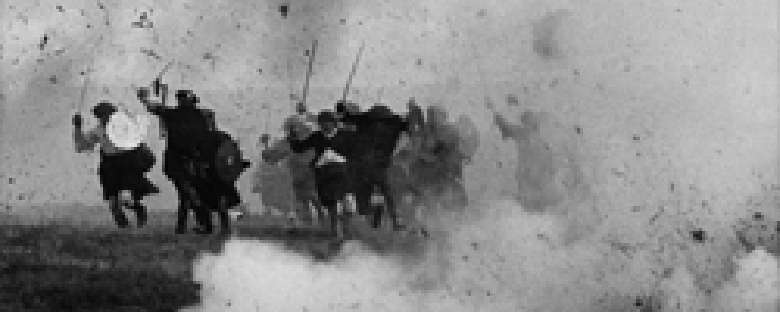Reviews
Peter Watkins
UK, 1964
Credits
Review by Leo Goldsmith
Posted on 22 August 2006
Source Project X / New Yorker DVD
Related articles
Features: The Radical Histories of Peter Watkins
Features: Two Early Television Documentaries by Peter Watkins
Reviews: The War Game
As one reviewer noted, it offers a considerable contrast from the old CBS television docudrama that confidently announced, “You Are There.” The Battle of Culloden [sic] makes us wonder: “Are We There?”
—Robert Brent Toplin,
“The Filmmaker as Historian”
in The American Historical Review 93.5 (1988)
Of course, the experience of watching Culloden never seriously challenges the viewer’s notion of present reality or the reality of that which is on-screen. One is never persuaded that one is watching an actual documentary made in 1746, nor does one suspect that the filmmakers are ignorant of a gross anachronism. Nonetheless, the film effectively disorients us by defying what we expect to see in a historical reconstruction or documentary on television, and that it continues to do so today indicates the radical nature of what Watkins was doing in 1964. Culloden achieves its effect primarily through the glaringly anachronistic presence of a TV crew on Culloden Moor, but this device raises fewer questions about tense (which become a significant and deliberate problem in The War Game) than it does about perspective. Essentially, the film begs its spectator to wonder who and where she is in relation to the historical events being reconstructed in the film.
The problems of perspective are inscribed in the film in the form of a number of sources, eyewitnesses, and positions put forward in “man-on-the-street” interviews. Most prominent among these is Andrew Henderson, biographer of the Duke of Cumberland (who commanded the English forces) and eyewitness to the battle. Henderson is positioned behind a stone wall throughout the film, overlooking the action through a telescope and commenting on what he sees. “I am going to have to shout to make myself heard,” Henderson warns as the English cannons begin their bombardment of the Jacobite lines, and smoke, screaming, gunshots, and crossfire often interrupt his commentary for the remainder of the battle. In spite of his position behind the English lines, Henderson’s gruesome account of the battle has the measured tone of a relatively impartial observer, but his physical relation to the action (and especially his use of the apparatus of the telescope and the fact that he is not only addressing the camera, but also dictating what he sees to a scribe seated next to him) serve to undermine his observations of the battle. This is further emphasized in the film by the fact that we almost never see exactly what he comments on in any conventional pattern of shot-countershot editing.
Furthermore, the film continually pulls away from Henderson’s perspective (likely the most complete account of the battle) to various perspectives on both sides of the moor. English officers describe the clansmen as savages, haggard and ill-equipped clansmen (many of them mere boys) express loyalty to their clan rulers, and Highland clan rulers object to Charles Edward Stuart’s inept battle plan. Later in the film, once the battle has ended, the film seeks out other sources to narrate the subsequent “pacification” of the Highlands, which better resembles a brutal campaign of ethnic cleansing.
The multiplicity of voices and viewpoints that the film affords its spectator therefore serves to break down any notion of a single, complete position. If conventional war coverage in all its forms — from the univocal perspective of propaganda films to the blinkered embedded journalism of our own times — intends to provide an authoritative, singular vision of the conflict at hand, Watkins’ film strategically intersects a series of equally plausible and often conflicting points of view. Contrasting Watkins’ modes of address and identification with those of classical narrative film (as well as forms of propagandist films, such as Triumph of the Will), one sees how a film like Culloden serves to liberate the spectator from a hierarchy of perspectives governed by an individual character. In Culloden, there is no consensus, no authority, and no televisual “voice of God”; rather, the “you” of the television audience is left to grasp at the event as a complex and incommensurable whole.
The confusions of time and perspective that arise from the strategies employed in the film also serve to question conventional representations of history in film and television. Watkins’ professed goal of “bring[ing] a sense of familiarity to scenes from an 18th century battle” using the strategies of news broadcasts of the Vietnam War is also a project of re-historicizing the figure of Bonnie Prince Charlie, an icon of romantic poetry and song, and a hero of the novels of Walter Scott. Watkins’ film not only challenges the spectator’s sense of historical and narrative authority, it also seeks to re-open a closed, seemingly stable, and decidedly ahistorical version of history, reconnecting it with a contemporary political context. It accomplishes this largely by addressing not only what happened in the battle of Culloden, but also what could have happened. By invoking the “if” of the battle of Culloden — if a less flat and featureless location had been chosen, if the Jacobite rebel army had had adequate time to rest or eat before the battle, if Charles Edward Stuart had not put all of his faith in Sir John MacDonald as a battle-strategist — Watkins not only links the spectator’s present to the past, but also uproots the spectator’s notion of both past and present as stable, closed, or definitive.
Culloden was received mostly with praise by viewers and critics alike, with only minor objections about the film’s extreme violence and (deliberately) problematic mode of address. His next film, The War Game, was not so welcomed.
We don’t do comments anymore, but you may contact us here or find us on Twitter or Facebook.



